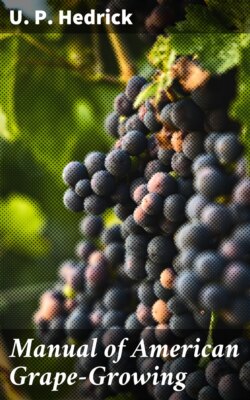Читать книгу Manual of American Grape-Growing - U. P. Hedrick - Страница 60
На сайте Литреса книга снята с продажи.
Vineyard grafting in eastern America.
ОглавлениеFig. 8. Cutting off the trunk.
In eastern America, the growing vine is usually grafted. At the New York Agricultural Experiment Station, the operation is very successfully performed on old vines as follows: Preparatory to grafting, the earth is removed from around the stock to a depth of two or three inches. The vines are then decapitated at the surface of the ground and at right angles with the axis of the stock. If the grain is straight, the cleft can be made by splitting with a chisel, but more often it will have to be done with a thin-bladed saw through the center of the stock for at least two inches. The cion is cut with two buds, the wedge being started at the lower bud. The cleft in the stock is then opened, and the cion inserted so that the cambium of stock and cion are in intimate contact. If the stock is large, two cions are used. The several operations in grafting are shown in Figs. 8, 9, 10 and 11. Grafting wax is unnecessary, in fact is often worse than useless, and if the stock is large the graft is not even tied. Raffia is used to tie the graft in young vines. It suffices to mound the graft to the top of the cion with earth, for the purposes of protection and to keep the graft moist. Two or three times during the summer, sprouts coming from the stock or roots from the cion should be removed.
Fig. 9. Cutting the cleft.
A method used with fair success at the New York Agricultural Experiment Station with young vines is to plant one-year-old stocks in the nursery row as soon as the ground can be worked in the spring. Just as the vines start in growth, these are cut off at the surface of the ground and whip- or cleft-grafted with a two-eye cion. The graft is tied with raffia, after which it is all but covered with a mound of soil. This is a case in which the work must be done at the accepted time, as it is fatal to delay.
Fig. 10. Inserting the cion.
R. D. Anthony describes another method as follows:[2] "A method which a Pennsylvania grower of Viniferas has found very satisfactory is to root the Vinifera cuttings, and grow them one year on their own roots; then the vine which is to be used as a stock is planted in the vineyard and the rooted cutting planted beside it so that the shoots from the two may be brought in contact with each other. In June when the plants are in full growth, two vigorous shoots (one from each vine) are brought together and a cut two or three inches long made in each parallel to the length of the cane removing from one-third to one-half of the thickness of the shoot. These flat surfaces exposed by the cuts are then brought into contact with the cambium tissues touching and are tied in place. The tops are checked somewhat by breaking off some of the growth. The following spring the Vinifera roots are cut off below the graft and the top of the stock above the graft is removed."
Fig. 11. The completed graft.
In the subsequent care of these young vines, the grower must take time by the forelock and tie the grafts to suitable stakes; otherwise they are liable to be broken off at the union by wind or careless workmen. Grafted vineyards must have extra good care in all cultural operations, and even with the best of care from 5 to 50 per cent of the grafts will fail or grow so poorly as to make regrafting necessary, this being the most unfavorable circumstance of field grafting. Regrafting is done one joint lower than the first operation to avoid dead wood; this brings the union below the surface of the ground, and the vineyardist must expect many cion roots to try his patience.
